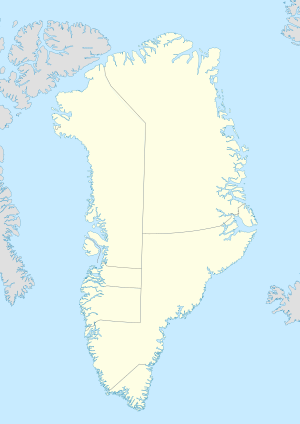Kullorsuaq
| Kullorsuaq | |
|---|---|

Wooden houses in Kullorsuaq
|
|
| Location within Greenland | |
| Coordinates: 74°34′45″N 57°13′05″W / 74.57917°N 57.21806°WCoordinates: 74°34′45″N 57°13′05″W / 74.57917°N 57.21806°W | |
| State |
|
| Constituent country |
|
| Municipality |
|
| Founded | 1928 |
| Population (2013) | |
| • Total | 448 |
| Time zone | UTC-03 |
| Postal code | 3962 Upernavik |
Kullorsuaq (old spelling: Kuvdlorssuaq) is a settlement in the Qaasuitsup municipality in northwestern Greenland. It is the northernmost settlement in the Upernavik Archipelago, located on Kullorsuaq Island at the southern end of Melville Bay, itself part of the larger Baffin Bay.
The settlement was founded in 1928 and became a trading station, growing in size after World War II when hunters from several small villages around Inussulik Bay, Sugar Loaf Bay, and Tasiusaq Bay moved into the larger settlements such as Nuussuaq and Kullorsuaq. Today, Kullorsuaq remains one of the most traditional hunting and fishing villages in Greenland, but maintains a stable population.
The name of the settlement means "Big Thumb" in Kalaallisut, after the Devil's Thumb, a prominent pinnacle-shaped mountain in the center of the island about 3 km (1.9 mi) north of the settlement.
Kullorsuaq is located on an island of the same name at the southern end of Melville Bay. The island is the northernmost part of Upernavik Archipelago.
The Upernavik Archipelago was among the earliest-settled areas of Greenland, the first migrants arriving approximately 4,000 years ago. All southbound migrations of the Inuit passed through the area, leaving behind a trail of archeological sites. These first settlers belong to the Saqqaq culture but were followed around 3,000 years ago by the Dorset culture, which spread along the coast of Baffin Bay. In the 13th and 14th centuries, the Dorset were themselves displaced by the Thule people.
The archipelago has been continuously – but sparsely – inhabited over this period. Migrants in the 19th and early 20th centuries found many ruins of Inuit settlement on Kullorsuaq, Kiatassuaq, and other smaller islands around Melville Bay, although Danish settlers during the colonial era were unaware of Kullorsuaq until the end of 19th century.
...
Wikipedia

